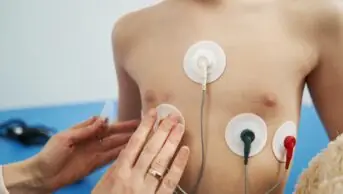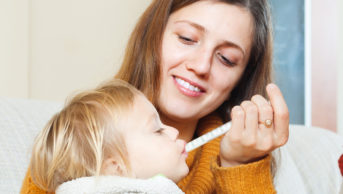This content was published in 2005. We do not recommend that you make any clinical decisions based on this information without first ensuring you have checked the latest guidance.
The role of the paediatric pharmacist in delivering pharmaceutical care to children and young people is increasing in significance. Paediatric pharmacy encompasses all the clinical specialties present in adult medicine (including oncology, transplantation and neurology) and paediatric pharmacists must therefore have a working knowledge of all these areas. They must also have a sound knowledge of the concepts of drug use and medicines management across the whole range of ages — from birth and in neonatal intensive care units, through to adolescence and the transition to adult medicine.
The recent publication of the National Service Framework (NSF) for Children, Young People and Maternity Services has highlighted the opportunities for paediatric pharmacists to develop their role in delivering pharmaceutical care to children and young people and to their parents or carers.1 It states that pharmacists are in a prime position to maximise the safe and effective use of medicines and influence the management of medicines for children and young people in primary care.
Background
Approximately 80 per cent of all childhood illnesses can be dealt with at home. However, the other 20 per cent will be of varying severity and may require medical intervention. In a typical year, pre-school and school children visit their GP approximately six times and three times, respectively. Fifty per cent of infants aged less than 12 months and 25 per cent of children aged between one and five years attend accident and emergency (A&E;) deparments at least once a year.
Of the total number of births in the UK each year, 10 per cent of neonates will spend time on a neonatal unit, 2 per cent of whom will require neonatal intensive care support.
Prescribing decisions
Although everyone may be familiar with the mantra “children are not little adults and cannot be treated as such”, it is often overlooked. Children’s bodies handle medicines differently from those of adults and wide variations occur between different age groups. Therefore, care and attention needs to be paid when making prescribing decisions for children, which must take into account their stage of development. Lack of evidence on the use of medicines in children leads to uncertainty in dosing. Even at the most appropriate dose, the use of medicines in children can lead to differences in effectiveness and adverse effects compared with use in adults.
More than any other patient group, drug treatment in children needs to be adjusted to response. Monitoring and adjustment of therapy requires a detailed knowledge of variations in pharmacokinetics and pharmacodynamics as well as other factors that influence efficacy, such as administration, formulation and absorption. However, there are no special systems in place to help parents manage their children’s medication effectively, which is a particularly important issue in chronic medical conditions such as epilepsy. In many cases, these families may receive less information than others since patient information leaflets (PILs) are often not relevant to paediatric conditions. Pharmacists are in a unique position to provide this expertise in an acute and chronic setting in both primary and secondary care.
Patient information
The national move towards using manufacturers’ patient packs may provide problems for pharmacists working with children. Legally, PILs must be provided even if the medicine is being used in an off-label manner, eg, because of the age of the patient. However, PILs often contain information that either is not relevant or may be alarming to patients, and the paediatric pharmacist has a pivotal role in ensuring that the parent or carer’s confidence is maintained in both the treatment itself and the multidisciplinary team.
Adequate information should be made available so that the parent, carer or, where appropriate the young person can make an informed decision regarding their medicines. Additional information should be given if possible and generic leaflets are available for parents and adolescents explaining the use of unlicensed and off-label medicines. The feasibility of producing nationally available information leaflets for using such medicines in children is under discussion. It is hoped that this process will engage the views of children and parents and that the information will in the future be available in suitable formats for different age groups.
Concordance
Paediatric pharmacists have a key role to play in the delivery of pharmaceutical care as part of a multidisciplinary team. As the concept of compliance (the extent to which the prescriber’s instructions are followed) is now widely regarded as outdated, the aim is to achieve concordance, where the patient is an active participant in decisions about their treatment. Time, effort and understanding are needed in order to achieve effective use of medicines in children. Children and parents need to be active partners in discussions about their medicines, in which the risks and benefits of treatment are considered. The values and beliefs of children and parents must be taken into account, as well as the effects of proposed treatment on daily living.
Self-medication programmes within hospital have been highlighted as a good way of aiding concordance in adults. The NSF for Children, Young People and Maternity Services now recommends the same principle as an example of good practice within the paediatric setting. However, the process is far more complex for those children whose parents or carers are intermittently looking after them and every dose that the child has to take is different. Self-medication programmes can work for these children and offer a great opportunity for the whole medicines concordant relationship to develop. Nevertheless, there has been little evaluation of self-medication programmes for children and models of best practice need to be developed and evaluated.
Medicines at school
School age children may have to take medicines during the school day. This can cause problems, especially if the school does not have a robust policy on the storage, handling and administration of medicines. These problems can often be overcome by using the pharmacist’s knowledge in drug selection and dosing to allow for either once- or twice-daily drug administration. Spreading best practice more widely through involvement with primary care trusts and local education authorities could have major benefits for children in these circumstances.
Teachers may need support in managing medicines in schools. Pharmacists have an opportunity to be involved in the development of medicines policies in schools and to provide training for teachers to enable them to support pupils with long-term medical conditions who need to take medicines in school. Development of pupil-focused education initiatives around health and drugs is also a possibility.
Licensing issues
On paediatric wards, at least 25 per cent of medicines prescribed are used outside their product licence.2–4 This is often considered central to many of the issues in paediatric medicines management and is unavoidable because most new drugs that go through the licensing process have only been investigated for adults. This lack of evidence in safety and efficacy raises specific issues for clinical governance and presents a particular challenge to paediatric pharmacists. Children should not be denied effective treatment simply because of the licensed nature of a drug for a particular age group. Pharmacists are in a unique position to evaluate the evidence, risks and consequences of drug use and inform other health care professionals appropriately.
In September 2004, the European Commission accepted a proposal entitled “Better medicines for children” which was designed to encourage more research to be carried out on medicinal products for use in children.5 It is hoped that this will become European law in late 2006, leading to more licensed products for children.
Problems brought about by the lack of paediatric licensed medicines include crushing tablets to form suspensions, using vials containing 100 times overdose amounts for neonates, suspensions containing enough alcohol to seriously harm an infant and a general lack of evidence for dosing. Formulation and administration can directly affect treatment efficacy. Once again, pharmacists are uniquely qualified to advise and influence treatment, and risk management assessments of all new drugs, formulations and preparations should form part of this role. Risk assessment should include a review of the appropriateness of the formulation and the potential for error in normal use. Systems to minimise the potential for error should be designed.
Discharge planning
The sometimes complex nature of medicines used in children described above can cause problems when children are discharged from hospital and can pose significant risks (eg, medicines may be unlicensed and difficult to source, information regarding appropriate doses may be difficult to obtain from standard sources or special formulations may be required). Parents often report difficulty in obtaining repeat supplies of unlicensed medicines. However, GPs, community pharmacists and other health care professionals are expected to manage a child’s treatment and provide continuing supplies.
Many of these issues arise because of poor discharge planning and communication or lack of appropriate information. The potential role of the pharmacist in improving paediatric medicines management at the primary and secondary care interface is obvious. Developing a local, standardised approach across all sectors of health care may be one way of addressing the issues. The National Pharmaceutical Association has recommended the introduction of a medicines management support programme, specifically designed to support families with complex medicines management needs. Developed through joint working across primary, secondary and tertiary care, this approach could help improve patient care and minimise risks for children who need to take such medicines.
Formularies
There are several paediatric and neonatal formularies currently in use within the UK. These are centre specific and include the Alder Hey formulary, Guy’s and St Thomas’ formulary and the Neonatal Formulary devised by the Northern Neonatal Network. In 1999, Medicines for Children was launched. This is a collaborative publication between the Neonatal and Paediatric Pharmacist Group (NPPG) and the Royal College of Paediatrics and Child Health (RCPCH). The NSF for Children, Young People and Maternity Services states: “substantial safeguards will be in place if prescribers routinely refer to the formulary Medicines for Children”. These information sources are important to paediatric pharmacists in providing informed advice for the recommendation and dispensing of medicines which are either unlicensed or being used in an off-label manner.
The summer of 2005 will see the launch of the British National Formulary for Children (BNF-C). The BNF-C will build on the success of Medicines for Children and has been developed as a result of a unique collaboration between the publishers of Medicines for Children and the publishers of the BNF (British Medical Association and the Royal Pharmaceutical Society). Produced by a team of editors and using a network of expert advisers, the BNF-C will provide a unique resource reflecting the evidence base, where available, for the current use of medicines in children. It will be available in book format initially, with electronic versions, including a personal digital assistant version, following soon after. The BNF-C also aims to evolve and improve with the help of its users via focus groups and feedback.
Networking
Membership of the NPPG has increased annually since it was formed in 1994 and the group now has 250 members. An annual conference is held and includes guest lectures from eminent people in the field of paediatrics and neonatology, together with workshops. Networking is an essential component of the conference and allows pharmacists and technicians to share their ideas, thoughts and experiences. Subgroups have formed as a result of networking to support pharmacists in specialist areas such as oncology and paediatric intensive care. Study days are often held throughout the year.
Underpinning the potential role of pharmacists in paediatrics is the development of knowledge and skills. In spring 2002, the Faculty of Neonatal and Paediatric Pharmacy was launched in association with the College of Pharmacy Practice. This faculty provides professional support for pharmacists in the UK interested in or working in the field of paediatrics. The faculty works closely with the NPPG. The aim is to provide a career pathway for practitioners, with competence assessed and acknowledged by experts in the field of neonatal and paediatric pharmacy.
Postgraduate education
At the moment, there are no nationally recognised training schemes or mandatory postgraduate qualifications for pharmacists wishing to work in this field. Experience is normally gained on a day-to-day basis with the support of more experienced paediatric pharmacists, by attending conferences and from study days and journal reading. Paediatric pharmacy expertise may be limited locally due to lack of specific education and training. This lack of underpinning support often puts pharmacists off becoming involved in paediatrics as it is viewed as a complex area of practice. A wider, structured networking of paediatric expertise may help with the provision of training and enable sharing of knowledge and experience and the development of a consistent approach to specific paediatric issues.
The NSF for Children, Young People and Maternity Services has a strong emphasis on ensuring competence to practice. This is not only in terms of being able to put clinical skills and knowledge into practise, but also by highlighting issues such as health promotion for children and their families and child protection. It is essential that the workforce dealing with children is fully competent to work in this area and the Faculty of Neonatal and Paediatric Pharmacy is working hard at many levels to try to ensure that this is the case in the future.
The faculty is working closely with both NHS Education for Scotland and the Centre for Pharmacy Postgraduate Education to produce distance learning packages to aid the knowledge and skill requirements set by the faculty and encouraged within the NSF for Children, Young People and Maternity Services. Packages from both these centres are expected to be available in 2005.
A number of schools of pharmacy offer modules in paediatrics with their postgraduate courses. However, few of these modules, if any, are aimed at or attract pharmacists from primary care.
There are currently no postgraduate courses available for more experienced paediatric pharmacists, although the School of Pharmacy, London, recently piloted an advanced paediatric module that was targeted at such pharmacists. Six pharmacists successfully completed this course this year and it is hoped that this course will continue to be run over the coming years.
Conclusions
Paediatrics is a unique and rewarding area of pharmacy practice. However, there are challenges in overcoming the significant gaps in paediatric pharmaceutical care that exist. Perhaps the most important challenge is making the necessary knowledge, skills and support network available to all pharmacists. It would be a shame if the lack of such an infrastructure prevented pharmacists from developing innovative solutions and grasping the opportunities to improve pharmaceutical care for children and parents.
References
1. Department of Health. National service framework for children, young people and maternity services. London: The Department;2004
2. Conroy S, Choonara I, Impicciatore P, Mohn A, Arnell H, Rane A et al. Survey of unlicensed and off-label drug use in paediatric wards in European countries. BMJ 2000;320:79–82
3. Turner S, Longworth A, Nunn AJ, Choonara I. Unlicensed and off-label drug use in paediatric wards — prospective study. BMJ 1998;316:343–5
4. Dick A, Keady S, Brayley S, Mohamed F, Lloyd BW, Thomson MA et al. Use of unlicensed and off-label medications in paediatric gastroenterology with a review of the commonly used formularies in the UK. Alimentary Pharmacology and Therapeutics 2003;17:571–5
5. MHRA/Department of Health. Strategy on medicines for children.


